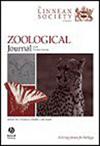A reappraisal of the family status of Neotropical Protoneuridae (Odonata: Zygoptera) using morphological and molecular information
IF 2.8
2区 生物学
Q1 ZOOLOGY
引用次数: 0
Abstract
Several comprehensive studies have greatly contributed to the clarification of Odonata phylogeny, paying special attention to the damselflies (Zygoptera). Nearly half of the species of Zygoptera are included in the family Coenagrionidae, but the status of some previously recognized families is still debated. Here, we present the results of phylogenetic analyses based on nuclear and mitochondrial sequences and morphological data of 10 of the 15 Neotropical genera formerly included within the Neotropical family Protoneuridae, with the goal to test their monophyly and phylogenetic position within the Coenagrionidae sensu lato. Our analyses support the polyphyly of Protoneuridae, with Proneura prolongata and Junix elumbis falling within the ‘core’ Coenagrionidae, whereas the remaining Neotropical Protoneuridae included in our analyses form a monophyletic clade, sister to the ridged frons Coenagrionidae. Our results differ from previous analyses that suggested that the Protoneuridae were members of the ridged frons Coenagrionidae clade, most likely because our dataset has a wider coverage of the group, both in terms of taxa and data sources. We propose the redefinition of the Protoneuridae (excluding Proneura, Junix, and all the previously included Old-World genera) and its re-establishment as a redefined Protoneuridae family, which is characterized by several morphological and biological unique attributes.利用形态学和分子信息对新热带原鹬科地位的重新评价
一些综合性的研究对蜻蜓目系统发育的澄清做出了很大的贡献,特别是对豆娘(刺翅目)的研究。近一半的钩翅目物种被归为锥蝽科,但一些先前确认的科的地位仍有争议。本文基于原神经科15个新热带属中10个属的核、线粒体序列和形态数据,对其进行系统发育分析,以验证其在原神经科中的单系性和系统发育地位。我们的分析支持原神经科的多聚性,其中protoneura prolongata和Junix elumbis属于“核心”Coenagrionidae,而我们分析中剩余的新热带原神经科形成了一个单系分支,与Coenagrionidae的脊状姊妹。我们的结果与之前的分析结果不同,之前的分析表明原euridae是脊状的Coenagrionidae分支的成员,很可能是因为我们的数据集在分类群和数据源方面都有更广泛的覆盖范围。我们建议重新定义原euridae(不包括protoneura, Junix和所有先前包括的旧大陆属),并将其重新定义为原euridae科,该科具有几个形态学和生物学上的独特属性。
本文章由计算机程序翻译,如有差异,请以英文原文为准。
求助全文
约1分钟内获得全文
求助全文
来源期刊
CiteScore
6.50
自引率
10.70%
发文量
116
审稿时长
6-12 weeks
期刊介绍:
The Zoological Journal of the Linnean Society publishes papers on systematic and evolutionary zoology and comparative, functional and other studies where relevant to these areas. Studies of extinct as well as living animals are included. Reviews are also published; these may be invited by the Editorial Board, but uninvited reviews may also be considered. The Zoological Journal also has a wide circulation amongst zoologists and although narrowly specialized papers are not excluded, potential authors should bear that readership in mind.

 求助内容:
求助内容: 应助结果提醒方式:
应助结果提醒方式:


